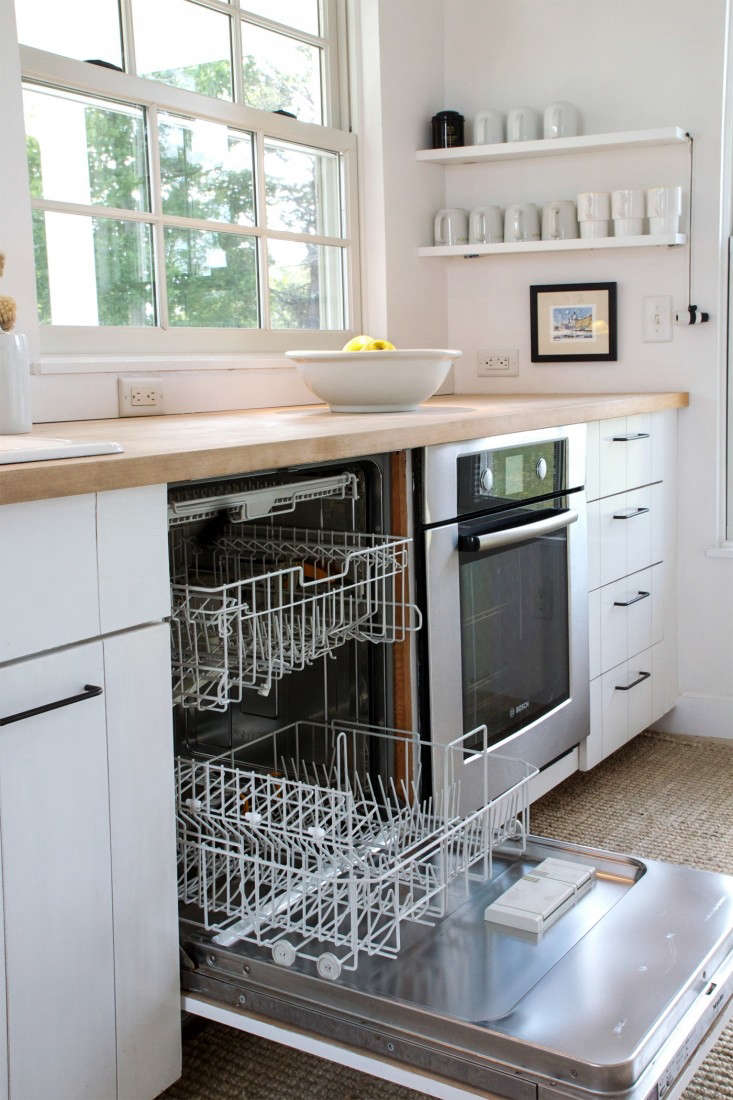Your average household dishwasher sees a lot of use. But when it gets near the end of its life cycle, you might notice that it’s leaking, not draining properly, or not doing its one job: delivering clean dishes. Time to go shopping!
In this miniseries we’re answering common questions about replacing your appliances. (See our post on replacing your refrigerator here.) To get the right answers, we consulted with Andrea Zaff of Boston-based Zaff Architecture, who specializes in helping her clients source appliances.
Here are seven questions to ask when swapping out your tired dishwasher for a new one.

Are all dishwashers the same size?
Most dishwashers are one of three basic types: standard, compact, or custom. Depending on the manufacturer, the standard and compact models can vary slightly in width, depth, or height, which could make a difference during installation.
Standard
Standard size is generally listed as 24 inches wide, 24 inches deep, and 35 inches high, with leveling feet that let you adjust the height to fit neatly under the counter. But the dishwasher itself may measure 23 5/8 by 23 5/8 by 34 inches—some wiggle room is required to get the unit into place and hook it up.
Compact
Compact or space-saving dishwashers are 24 inches deep by 35 inches high, but typically only about 18 (or 17 5/8) inches wide.
Custom
Custom (also called oversize) models are wider or taller than the standard dishwasher. There aren’t many on the market, however, due to poor performance. “If you really need capacity, it’s better to install two 24-inch units,” Andrea Zaff says. “This has been a life saver for some of my clients who have busy lives.”
Other Options
Portable stand-alone dishwashers are also available, and can be a solution in a kitchen where the sink isn’t close to where you’d want to install a dishwasher. And there are also dishwasher drawers (see Remodeling 101: The Ins and Outs of Dishwasher Drawers), which allow you to wash small loads economically.

How do I know if my new dishwasher will fit in the existing space?
If you’re replacing one standard-size unit with another, chances are good that the new one will slide right in. However, Andrea warns, “In an older home you might find that once the old dishwasher is removed, the distance between floor and counter isn’t quite what you’d expected. If your flooring was laid down over older flooring, for example, it might not extend under the dishwasher and cabinets. And if the finished floor is higher than where the dishwasher sits, it may be hard to get the old dishwasher out.”
If there’s any doubt, Andrea recommends you take precise measurements of your existing space, then check the specifications or consult with a salesperson regarding the model you’re interested in. You may have to remove the old dishwasher to get the dimensions of the rough opening.

I’m upgrading to a fancy new dishwasher. Will I need to upgrade the wiring and/or the plumbing?
A dishwasher requires electricity, a hot-water pipe, and a drain. If you’re installing your new unit in the same location, the electrical and plumbing hookups will already be in place, so it’s likely that no changes will be needed. But Andrea notes: “Since 2014, the National Electric Code has required a dishwasher to have a dedicated circuit (one not shared with other appliances), with a GFCI-protective device installed on the circuit breaker panel for extra protection. It must also have a shut-off valve within four feet of the appliance.” The electrician installing the new unit will be able to confirm all of that.
Depending on the local plumbing code, you may need to install an air gap in the countertop to make sure that water can’t siphon from the sink (if the sink were full) into the dishwasher and then all over the floor.
If your sink lacks an available hole for installing an air gap, your plumber can usually drill one. Another way to provide a hole is to replace the standard sink faucet with a post-type faucet, which doesn’t have the rectangular mounting plate at its base. Without the mounting plate, two holes will be exposed at the rim of the sink. One of these can be used for an air gap; the other for a soap dispenser or hand-sprayer.

How can I make space to upgrade from a compact dishwasher to a standard-size one?
It can be done, though it generally means losing kitchen storage. “Each case is different, but you’ll probably have to remove existing cabinetry for your new dishwasher,” says Andrea. “Then you’ll need to add either a filler panel, open shelving, or a slender cabinet—perhaps a pullout cabinet for baking trays.”
Can I switch from a standard-size dishwasher to dishwasher drawers?
Most double dishwasher drawers have the same dimensions as a standard dishwasher, so there won’t be any problem fitting them in the existing opening. Note that when open, the drawers occupy a bit less space than a traditional pull-down door—which is helpful in a kitchen where space is at a premium.

How can I save energy—and money—with my new dishwasher?
“You’ll find the Energy Star rating—as well as the estimated energy use and cost per year—on the yellow tag displayed on the front of the machine,” says Andrea. According to the EPA’s Energy Star program, “Dishwasher technology has improved dramatically over the last decade… . Standard-size dishwashers that have earned the Energy Star are on average 12 percent more energy efficient and 30 percent more water efficient than standard models.” That helps the environment and also saves consumers money. Bonus: The new dishwashers are both quieter and more efficient.

What do I do with my old dishwasher?
The retailer who sold you the new unit will probably remove it when they make delivery. But if you’re not sure where the old unit will go after that, you might want to take disposal into your own hands. The Energy Star program offers advice on recycling old appliances.
If your old dishwasher still works, you might sell it on Craigslist or eBay. Or you could donate it to a recycling center (some offer cash for old appliances) or a nonprofit such as Eco Building Bargains, Goodwill, or Habitat for Humanity, where goods are recycled and resold rather than dumped in a landfill. (The donation may give you a tax write-off in the next fiscal year.)
For more on sourcing a new dishwasher, see 10 Easy Pieces: Front-Loading Dishwashers. And stay tuned for more posts in this miniseries: Next we’ll cover What to Know When Replacing Your Washer/Dryer and What to Know When Replacing Your Range.
More dishwasher essentials:
- Domestic Science: How to Clean a Dishwasher
- Domestic Science: How to Load a Dishwasher
- Remodeling 101: 8 Sources for Used Appliances
Finally, get more ideas on how to evaluate and choose a kitchen dishwasher in our Remodeling 101 Guide: Kitchen Dishwashers.
Frequently asked questions
When should I consider replacing my dishwasher?
There are several reasons to consider replacing your dishwasher:
Frequent breakdowns: If your dishwasher requires frequent repairs and is no longer reliable, it may be more cost-effective to replace it.
Inefficiency: Older dishwashers may be less energy-efficient, leading to higher utility bills. Upgrading to a more efficient model can help save energy and money in the long run.
Aesthetic considerations: If you're remodeling your kitchen or updating its style, replacing your dishwasher can contribute to the overall look and functionality.
What factors should I consider when choosing a new dishwasher?
Consider the following factors when selecting a new dishwasher:
Size and dimensions: Ensure that the new dishwasher will fit within the available space in your kitchen.
Capacity: Choose a capacity suitable for your household's dishwashing needs. Consider factors like the number of people in your household, average meal size, and frequency of dishwashing.
Energy efficiency: Look for dishwashers with ENERGY STAR certification or high energy-efficiency ratings to save on energy costs and reduce environmental impact.
Noise level: If noise is a concern, look for dishwashers with low decibel ratings.
Cleaning features: Consider options such as different wash cycles, adjustable racks, soil sensors, and additional features like a sanitize or delay-start option.
Budget: Determine your budget range and find dishwashers that fit within that range.
Should I hire a professional for the installation, or can I do it myself?
While it is possible for some individuals to handle the installation themselves, it is generally recommended to hire a professional for safety and compliance reasons. A professional installer can ensure that the dishwasher is properly connected to the water supply, drainage system, and electricity, and that it meets local building codes.
Do I need to measure my space before purchasing a new dishwasher?
Yes, it is crucial to measure the available space accurately before purchasing a new dishwasher. Measure the width, height, and depth of the space to ensure the new dishwasher will fit properly. Additionally, consider any clearance requirements specified by the manufacturer or local building codes.
Can I switch from a built-in dishwasher to a portable dishwasher, or vice versa?
In most cases, it is possible to switch from a built-in dishwasher to a portable dishwasher or vice versa. However, it may involve additional considerations and modifications. Built-in dishwashers require a dedicated space with plumbing connections, while portable dishwashers can be moved around and connected to a faucet. It's recommended to consult with a professional or refer to the manufacturer's guidelines for specific requirements.
What are the plumbing requirements for installing a dishwasher?
The plumbing requirements can vary depending on the specific dishwasher and local building codes. However, the general requirements include:
Water supply: Ensure that the dishwasher has access to a hot water line. Some dishwashers may also require a cold water connection for specific wash cycles.
Drainage: Connect the dishwasher to a suitable drainpipe or install a proper drain system.
Air gap or high loop: Depending on local codes, you may need to install an air gap or a high loop in the drain line to prevent backflow.
Are there any specific electrical requirements for installing a dishwasher?
Dishwashers typically require a dedicated 120-volt electrical circuit. It's important to follow the manufacturer's guidelines and local building codes. Hiring a licensed electrician is recommended to ensure proper electrical installation.





Have a Question or Comment About This Post?
Join the conversation